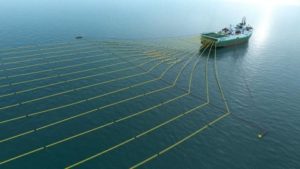Distributed fiber-optic hydroacoustic sensor
 The fiber-optic sensor being developed represents a distributed phase array of hydroacoustic signals. It will be exploited as a towed seismic streamer in active marine seismic survey and as an ocean bottom seismic system for acquisition of microseismic events at underwater exploration of hydrocarbon reservoirs. Its long fiber-optic cable acts as a set of sequential sensing elements and simultaneously represents the data collection line.
The fiber-optic sensor being developed represents a distributed phase array of hydroacoustic signals. It will be exploited as a towed seismic streamer in active marine seismic survey and as an ocean bottom seismic system for acquisition of microseismic events at underwater exploration of hydrocarbon reservoirs. Its long fiber-optic cable acts as a set of sequential sensing elements and simultaneously represents the data collection line.
The system consists of three main parts, which are being developed in collaboration of different profile companies. The first part is hardware located on the surface, which includes optical, electronic and digital subsystems. The hardware part is being developed by our company. The second part is the actual sensing element of the system. It is a specially designed fiber-optic cable having a complex structure, which was given directional properties in space. And the third one is the software allowing to conduct digital signal processing in real time and also to automate analysis and interpretation of collected information.
The fiber optic cable has the length up to 10 km. At that, the sensor has exceptionally high spatial density of measuring channels: the distance between them is about 1 m. Thus, the system under development substitutes tens of thousands of conventional hydrophones and accelerometers. The sensor’s data rate reaches several Gbytes per second. Main characteristics of the measuring channels are close to characteristics of conventional electric sensors and much better than parameters of the best commercial analogues (at the condition when the optical fiber is identical). The target dynamic range of each measuring channel is 105 dB and better. The coefficient of harmonic distortions is as low as -60 dB.
In practice, the following properties of the sensor are particularly useful: reliability and high durability of the fiber-optic cable whose life span is about 25-30 years in sea water. The sensing element is suitable for deep water applications (at depths up to 2 km). Topology of the cable is arbitrary; that allows configuring spatial properties of the equivalent hydroacoustic antenna. Configuring of main sensor’s parameters can be done online programmatically.
We are looking for investors for the project’s funding. The current state of works (August 2018) is the prototype development, which is partially completed. For completion of this stage we need 5 mln RUR. The project draws attention from Russian marine seismic companies, (Yuzhmorgeologia) and oil companies (GazpromNeft).
For additional information, please call to the R&D center of Radiophotonics, St Petersburg.
Contacts:
e-mail: info@radio-photonics.ru
Mob.: +7 929 525 8710

 Русский
Русский